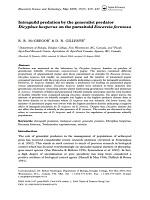Gillespie, David R.
Person Preferred Name
David R. Gillespie
Related Works
Content type
Digital Document
Abstract
Females of the egg parasitoid Anaphes iole Girault (Hymenoptera: Myrmaridae) accepted and oviposited in eggs of both Lygus shulli Knight and L. elisus Van Duzee (Heteroptera: Miridae) when presented on sections of green bean pod in the laboratory. Resulting A. iole larvae developed normally on eggs of both host species and emerged as adults. The wings of A. iole emerging from L. shulli eggs were significantly larger than those from L. elisus probably because the eggs of L. shulli were larger. Anaphes iole females parasitized only approximately 50% of the eggs available of either host species. This may indicate that 50% of the hosts were suitable and rejected, that 50% were unsuitable for oviposition, or that the structure of bean pods prevents females from finding or ovipositing in 50% of hosts. Anaphes iole has potential for biological control of Lygus spp. on greenhouse vegetables in southwestern British Columbia.
Origin Information
Content type
Digital Document
Abstract
The potential of Dicyphus hesperus Knight as a predator of greenhouse whitefly, Trialeurodes vaporariorum (Westwood), and two-spotted spider mites, Tetranychus urticae Koch, was assessed in the laboratory and in a tomato greenhouse. D. hesperus adults fed readily upon both pest species in the laboratory, and nymphs completed development from egg to adult on either whitefly or mites. Whitefly, however, were a superior food for growth and development of D. hesperus compared to mites. Development time was shorter and resulting adult body size was larger for nymphs reared on whitefly compared to those reared on mites. In a greenhouse release, adults oriented to and oviposited on whitefly-infested sentinel plants but did not orient to mite-infested sentinel plants. D. hesperus adults oviposited on greenhouse tomatoes and their progeny completed development in a greenhouse in which both whitefly and mites were present. The results are discussed as they relate to the use of D. hesperus for biological control of pests of greenhouse vegetables.
Origin Information
Content type
Digital Document
Abstract
Components of search effort were determined for adult females of Orius tristicolor (White) (Hemiptera: Anthocoridae) on bean, Phaseolus vulgaris L., leaves with either western flower thrips, Frankliniella occidentalis (Pergande) (Thysanoptera: Thripidae) or twospotted spider mites, Tetranychus urticae (Koch) (Acari: Tetranychidae) as prey. In the absence of prey, females of O. tristicolor allocated significantly more search time to leaves damaged by western flower thrips than to leaves damaged by twospotted spider mites, artificially damaged leaves or undamaged leaves. In the presence of prey, search time increased with increasing amounts of leaf damage for both prey species, but was not affected by prey species. Amounts of leaf damage or type of prey did not affect giving‐up‐time. The proportion of predators that successfully located thrips increased with increasing amounts of thrips damage on leaves. Females of O. tristicolor appeared to follow some simple, behavioural rules‐of‐thumb for allocation of search effort. The presence and type of damage determined the initial effort allocated to searching a leaf. Subsequent effort was determined by successful capture of prey, regardless of species. The implications of these results for application of Orius spp. for biological control are discussed. [ABSTRACT FROM AUTHOR]
Origin Information
Content type
Digital Document
Abstract
Dicyphus hesperus Knight (Heteroptera: Miridae) is an omnivorous predator used to control pests of greenhouse vegetables. Plant preferences and life history traits were studied using nine plant species: Lycopersicon esculentum Mill. (Solanaceae), Capsicum annuum L. (Solanaceae), Verbascum thapsus L. (Scrophulariaceae), Nepeta cataria L. (Lamiaceae), Stachys albotomentosa (Lamiaceae), Nicotiana tabacum L. (Solanaceae), Vicia sativa L. (Fabaceae), Zea mays L. (Gramineae), and Chrysanthemum coronarium L. (Asteraceae). Plants were selected from among potential target crops, natural hosts, plants used for mass rearing, and plants on which D. hesperus has not been reported. Plant preference was measured by multi-choice host plant selection and oviposition assays. Development and reproduction were measured on each of the plant species on both a plant diet alone and on a plant diet supplemented with Ephestia kuehniella Zeller (Lepidoptera: Pyralidae) eggs. Dicyphus hesperus females and nymphs expressed a preference for some plants over others. Plant preference ranged from low preference plants, such as Z. mays, V. sativa, C. coronarium, and C. annuum, to high preference plants such as V. thapsus, N. tabacum, and S. albotomentosa. When E. kuehniella eggs were supplied, there were few differences in the development time and fecundity of D. hesperus among plants, with the exception of corn and broad bean, where fecundity was lower. On a plant diet alone, nymphs were able to complete their development on V. thapsus, C. annuum, and N. cataria. However, mortality and development time were much lower on V. thapsus than on C. annuum and N. cataria. On most of the plant species D. hesperus did not lay any eggs when fed on a plant diet alone. On V. thapsus, females laid a few eggs and lived longer than when fed on prey. Dicyphus hesperus females tended to prefer host plants on which nymph survival without prey was greatest. [ABSTRACT FROM AUTHOR]
Origin Information
Content type
Digital Document
Abstract
Book Description "Biological control: a global perspective": This book contains 45 chapters divided into four sections, i.e. classical biocontrol programmes, inundative (or augmentative) biocontrol programmes (using nematodes, bacteria, fungi and viruses), conservation biocontrol programmes and networking in biocontrol. It describes the personal experiences of scientists from the initial search for suitable control agents against weeds and pests, to the release of these biological control agents into ecosystems and finally to the beneficial outcomes demonstrating the success of biological control across diverse agroecosystems.
Book chapter: Generalist natural enemies can be key members of biological control programmes. We believe that importation of generalist natural enemies for biological control should be avoided, and that endemic natural enemies should be used instead. We summarize our progress developing a generalist mirid, Dicyphus hesperus, for biological control in greenhouse tomato crops. Our success in locating a generalist mirid which can fill a niche in protected culture illustrates the potential for such approaches. This predator satisfies four of five preconditions that we set when we started the project and could potentially be used successfully as part of biological control programmes in greenhouses in North America.
Origin Information
Content type
Digital Document
Abstract
Book Description "Biological control programmes in Canada 2001-2012": This volume (71 chapters), the fifth in a series documenting biological control programmes in Canada, presents new information on specific insect, weed or plant diseases, some of which are updates of on-going studies on historical biological control projects while other chapters report on biological control efforts for new emerging invasive alien species. In each case, information is presented in a consistent and logical manner, starting with the pest status in Canada, followed by a comprehensive background on previous studies, review of the use of biological control in these programmes, and an evaluation of the biological control efforts and future needs in research or implementation activities. A total of 64 chapters is dedicated to biological control case studies over the past 11 years - 36 on insect pests of agricultural importance and forestry or ornamental pests; 18 on the control of weeds for crops, rangeland, pastures or aquatic areas; and 10 on the biological control of plant disease causal agents. This book is intended for researchers and students in biological control, pest management, ecology and risk assessment.
Chapter 14 "Bactericera cockerelli (Sulc), tomato/potato psyllid (Hemiptera: Triozidae)": This chapter describes the pest status and biological control (parasitoids, predators and pathogens) of B. cockerelli [Trioza cockerelli] (tomato/potato psyllid) in Canada.
Origin Information
Content type
Digital Document
Abstract
Cumulative temperature requirements and development thresholds were determined for two populations of Dicyphus hesperus Knight, 1943 to compare their suitability for use in biological control in greenhouse vegetable crops. The populations were from near Summerland, British Columbia, Canada (49°36′N, 119°40′W, at 334 m elevation) and from near Woody, California, United States of America (35°42′N, 118°50′W, at 500 m elevation). Eggs of the California (CA) population had a higher cumulative temperature requirement for hatch than those of the British Columbia (BC) population. Males of the CA population had a slightly lower cumulative temperature requirement for development from hatch to adult than males of the BC population. The populations did not differ with respect to development thresholds. Males of the CA population experienced higher mortality during development at 35 °C than BC males or females of either population. Males and females of both populations developing at 35 °C were significantly smaller than those developing at more moderate temperatures. The differences between populations with respect to development were biologically trivial. With respect to the effects of temperature on development time under greenhouse conditions, the two populations appear to be equally suitable for use in greenhouses.
Origin Information
Content type
Digital Document
Abstract
Evolutionary and ecological transitions from carnivorous to omnivorous feeding may be constrained by the ability of the animal to cope with disparate types of foods, even if preadaptations for such behaviour exist. The omnivorous true bug, Dicyphus hesperus (Hemiptera: Miridae) requires both animals (small, soft-bodied insects) and plants in its diet and obtains the majority of its dietary and metabolic water from plant feeding. Serrations on the lateral margins of the mandibular stylets wear with age, and this wear is exacerbated when the insects feed on plants compared to those provided free water and no plants. D. hesperus that feed on plants attack fewer prey but consumed similar amounts of prey tissue compared to individuals that were provided free water. Although others have shown mandible wear for plant-chewing animals we show for the first time that plant feeding can impose similar wear on plant-piercing animals as well.
Origin Information
Content type
Digital Document
Abstract
<i>Dicyphus hesperus</i> Knight has good potential as a biological control agent for greenhouse pests in greenhouse tomato crops. The spatial distribution of <i>Dicyphus hesperus</i> was studied and a sampling plan was developed to monitor this species in greenhouse-grown tomatoes. Adults and nymphs are distributed in a more aggregated pattern among plants than within plants. The strong, significant relationship between the mean population density and the proportion of occupied sample units (leaves or plants) makes it possible to use a binomial or presence-absence sampling approach. Presence-absence sampling is an efficient method for crop management purposes because less time is needed to process the samples compared with a method where all insects are counted. At high densities, considering a sample unit to be occupied only when there are more than a determined number of individuals reduces considerably the optimum sample size required.
Origin Information
Content type
Digital Document
Abstract
Predation was measured in the laboratory by Dicyphus hesperus females on patches of greenhouse whitefly (Trialeurodes vaporariorum) pupae. The patches contained different
proportions of unparasitized pupae and those parastisized as nymphs by Encarsia formosa. Dicyphus hesperus fed readily on parasitized pupae and the number of parasitized pupae consumed increased with the proportion available indicating a capacity for intraguild predation. However, D. hesperus females did not display a preference for feeding on parasitized pupae versus unparasitized pupae. Dicyphus hesperus adults were released at three densities into greenhouse enclosures containing tomato plants harbouring greenhouse whitefly and immature E. formosa. Numbers of killed and parasitized whitefly nymphs and pupae and the total number of healthy whitefly were compared among Dicyphus density treatments. On upper leaves, the amount of predation on whitefly nymphs was higher at the highest predator density than at the lower density or in enclosures where D. hesperus was not released. On lower leaves, the number of parasitized pupae was lowest with the highest predator density indicating a negative effect of intraguild predation by D. hesperus on E. formosa. Despite this, Dicyphus density did not affect the density of whitefly in the presence of E. formosa. The results are discussed as they
relate to concurrent use of D. hesperus and E. formosa for regulation of greenhouse whitefly populations. [Publishers abstract]
Origin Information




